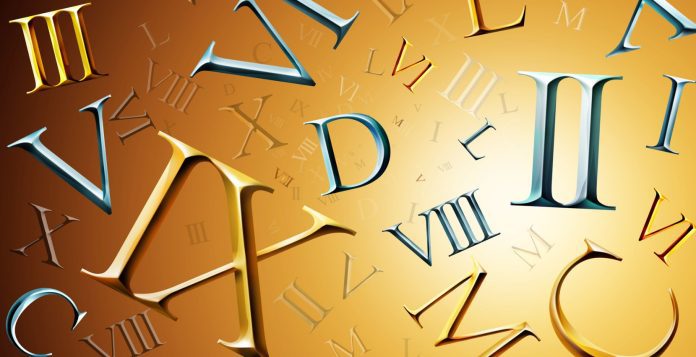Overview of the Roman Numeral System
Roman numerals I, V, X, L, C, D, and M represent 1, 5, 10, 50, 100, 500, and 1,000 in the Hindu-Arabic number system. After a sign of equal or higher value, the value of the earlier symbol is increased. Before a symbol with a higher value, its value is deducted. That is to say, the symbols first appeared between 900 and 800 B.C.
To indicate numbers starting with a 4 or a 9, a symbol is put before one of a larger value to deduct its value—for example, IV = -1 + 5 = 4, XC = -10 + 100 = 90, and CD = -100 + 500 = 400. Typically, only three similar symbols may be used sequentially. The only exceptions are clocks, which often show 4 as IIII, and the number 4,000, which is sometimes written as MMMM. When a vinculum bar is put over a number, the value is multiplied by 1,000.
Ancient Roman society used different ways to represent numbers, and one of the most common ways to show a number from 1 to 10 was with the help of fingers. The “V” stood for five fingers, notably the V-shaped pattern formed by the thumb and forefinger, whereas a single line, or “I,” stood for one unit or finger. Two crossed hands are equivalent to “X.”
Roman numerals in larger sizes evolved from other symbols. M = 1,000 — this number was once denoted by the Greek letter phi (ф). It was frequently referred to as C, I, and backward C; see this: CIƆ, which looks like an M. The fact that mille is the Latin word for a thousand is a coincidence.
D = 500 — originally, this number’s sign was IƆ — half of CIƆ.
C = 100 —originally, this number’s sign was theta — Θ — and later became a C. Coincidentally, it also represents centum, the Latin word for a hundred.
L = 50 — originally, this quantity was expressed by a superimposed V and I, or by the letter psi — Ψ — It became inverted-looking after flattening T and finally began to resemble an L.
Rules for Roman Numerals
Rule I: No Roman number may be used more than three times.
Rule II: L, V, and D are not duplicated in Roman numerals.
Rule III: The value of the number is determined by the sum of the Roman numerals when letters are repeated.
Rule IV: The number 0 or zero has no value.
Rule V: A new figure is created when a smaller number is placed to the right of a larger one by adding the smaller number’s value to the larger one.
Rule VI: To construct the new figure, when a smaller number is placed to the left of a larger one, the smaller number’s value is deducted from the larger number.
| You might also like: |
Numerals that come before and after XXV and XXVIII. How to Read and Write These Numerals?
Roman numeral XXV indicates 25, while XXVIII corresponds to the number 28. Here are the numbers that come before and after XXV and XXVIII and their meaning in the Arabic-Hindu numeral system.
XX = 20
XXI = 20 + 1 = 21
XXII = 20 + 2 = 22
XXIII = 20 + 3 = 23
XXIV = 20 + 4 = 24
XXV = 20 + 5 = 25
XXVI = 20 + 6 = 26
XXVII = 20 + 7 = 27
XXVIII = 20 + 8 = 28
XXIX = 20 + 9 = 29
The following techniques may be used to calculate the numerical value of XXV and XXVIII.
Approach 1: Using this approach, we separate the Roman numerals into individual letters, write each letter’s numerical value, and then add or subtract as necessary.
XXV equals 10+10+5 = 25
XXVIII equals 10 + 10 + 5 + 1 + 1 + 1 = 28.
Approach 2: Using this approach, we add or remove Roman numeral groups. For example,
XXV = X+X+V = 10+10+5 = 25
XXVIII = XX + VIII = 20 + 8 = 28.
Examples in History
As the Roman Empire was ruined, Christianity (ironically one of Rome’s earliest targets for persecution) continued to use the culture’s number system.
Roman numerals are employed to identify moons in astronomy and Periodic Table groupings in chemistry. Upper- and lower-case Roman numerals organize stuff into a readily organized structure, as seen in tables of contents and manuscript outlines. Besides, Roman numerals are used as notation symbols in music theory.
Also, they are one of the numbering systems used in contemporary mathematics that have been used throughout history.
Roman numerals can be met:
- On clocks and watches;
- Roman numerals are still used for book chapter headings and numbered points in print;
- Roman numerals are still used to refer to monarchs, queens, emperors, and popes with the same names (as in Louis XVI of France or Pope Benedict XVI), as well as in fields like chemistry, pharmaceuticals, seismology, and theology when appropriate; Roman numerals are still used to indicate book chapter headings and numbered points in print;
- Roman numerals may be used in the film industry to indicate the year that a film was produced;
- Roman numerals are used to denote the frequency of performances in athletic events like the Olympic Games, the Super Bowl and even in the best swedish casinos – no licence and casino utan svensk licens.
Concluding, Roman numerals bear not so practical but aesthetic reasons. Roman numerals visually have a timeless, historical feeling, which is particularly can be observed on clocks and watches.


































